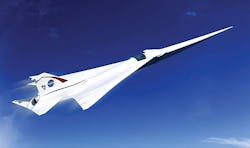NASA to develop next-generation supersonic passenger jet, but will the market support it?
A supersonic passenger jet could fly from New York to Los Angeles in less than three hours, New York to London in less than four, New York to Tokyo in six hours, and Los Angeles to Sydney in less than seven.
Such time savings. Such efficiency. It all sounds great, right? My only question: haven't we been here many times before?
The notion of supersonic passenger air travel isn't new; we've been talking about it since the 1950s during a period when U.S. military aircraft were making the transition from high-performance propellers to jet engines.
In that 60-year period only two kinds of supersonic passenger jets have seen commercial service -- the Anglo-French Concorde, and the Russian Tu-144. At their peak, only about 30 of these supersonic jetliners were in service, and none of them is flying today. In fact, there is no supersonic passenger service available today anywhere in the world.
Related: DARPA Black Swift seeks to capitalize on lessons learned from NASP
So what happened? In the 1960s widespread supersonic passenger travel was considered to be right around the corner. I remember as a six-year-old in 1965 being aboard a shiny new Continental Airlines Boeing 707 looking at artist renderings in the seat-back magazine of a near-future Continental supersonic transport (SST) passenger plane.
story continues below
It was amazing, and only a few years away. Soon, we thought, we'd all be on supersonic jets. All the old ones quickly would become obsolete and go the way of the old DC-3. The world, overnight, would become a much smaller place, thanks to the so-much-faster speeds of the anticipated new supersonic jets.
It was an optimistic time.
Yet as it is with most shining prospects, the promise was far more than the reality. The first supersonic passenger planes had deafening engines, created ear-splitting sonic booms, and threatened to pollute the upper atmosphere and dangerously warm the surface of the planet.
Related: Northrop Grumman designs supersonic UAVs for Air Force
Their noise and environmental footprints confined supersonic passenger jets to only a few airports in the U.S. The aircraft were small and expensive to operate compared to subsonic passenger jets of the day. Only the very rich could afford to fly on them. The Concorde, for example, entered service in 1976, but its operators gave up on it by 2003 because, among other things, it couldn't generate sufficient revenue.
Today, however, NASA aviation experts are making another run at a supersonic passenger transport, called the Quiet Supersonic Technology (QueSST) program. NASA officials announced Monday they have awarded a $20 million 17-month contract to Lockheed Martin to complete a preliminary QueSST design.
The new plane won't generate the obnoxious sonic booms of previous generations, and from the ground will be nearly inaudible at its cruising altitude of 40,000 feet. The environmental issues have been addressed, and the new planes, which could seat as many as 100 passengers, could fly as early as 2020.
I do have a couple of concerns, though. The first is, why are NASA and the taxpayers getting involved in this project at all? Supersonic aircraft technology has been around for more than half a century. The core question is would supersonic passenger planes be economically viable?
Related: Lockheed Martin laser weapons work tackling the problem of atmospheric turbulence
If the answer is yes, then Boeing, Lockheed Martin, Airbus, and other aircraft manufacturers could develop these planes on their own without government assistance. If the answer is no, then we shouldn't be wasting government money on supersonic passenger jets in the first place.
Another question is how big do supersonic passenger planes need to be to make economic sense? The latest ideas on the table say the future QueSST aircraft could carry as many as 100 people. That's about the size of a decent-sized regional jet like the Bombardier CRJ700 or the Embraer E-Jet. Does intercontinental air travel make sense with such small numbers? What's a ticket on a QueSST plane going to cost?
When supersonic passenger travel can help airlines turn a profit, then believe me, the aircraft manufacturers won't be able to build these aircraft fast enough to meet demand. Passenger fares will pay for technology development, airport infrastructure, and the air traffic control system necessary to handle them. Until that's a realistic prospect, then we ought to leave supersonic air transports alone.
Six decades of failure should drive the lesson home that the market, not the government, should determine when supersonic passenger flights are ready. I fear that day isn't close at hand.
